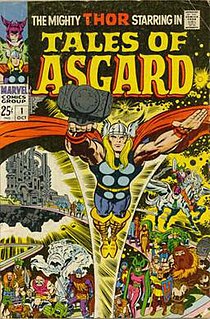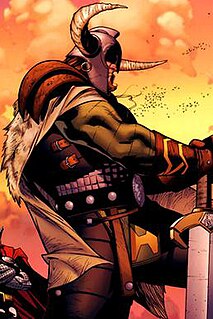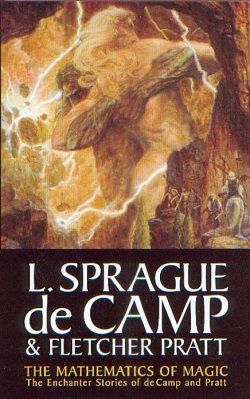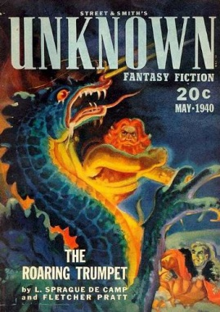Plot summary
Psychologist Reed Chalmers speculates that the mental problems of his patients may stem from their minds not being fully in tune with the world they live in, but rather, partially in sync with other, parallel universes. He holds that if their minds were to be correctly aligned they could be cured, and, contrarily, that if completely realigned to another universe, they would be projected into that universe. Chalmers has devised a system of symbolic logic to encode the underlying assumptions of a universe into a mathematical formula, the use of which he believes could affect such a realignment. He is, however, hesitant to put his theory to a practical test.
Chalmers's subordinate colleague Harold Shea has fewer qualms. Dissatisfied with his life, he attempts to use his boss's process to project himself into the world of Irish heroic mythology, where with his modern knowledge he thinks to set himself up as a wonder worker. However, interdimensional travel proves an inexact science, and he misses his target reality landing instead in the decidedly colder, bleaker world of Norse myth. Moreover, the adjustment is complete; now speaking Old Norse, Shea is unable to read the English language Boy Scout Handbook he has brought as a survival manual—worse, he finds his new world's superstitious, pre-scientific belief system encoded in its basic physics. His matches won't light, his stainless steel knife rusts, and magic actually works. Worst of all, the world is on the verge of Ragnarök, the final conflict between the Gods and the Giants.
Lost and freezing, Shea falls in with Odinn, who leads him to the mortal farmstead of Sverre, where the Gods are meeting. There he is befriended by the servant Thjalfi, through whose offices he comes under the dubious patronage of the malicious, mischief-making god Loki. More congenial is Loki's rival Heimdall, who fills Shea in on the situation. It seems that the gods face dim prospects in the coming battle, as two of their most potent magical weapons, Thor's hammer and Frey's sword, have been stolen by their enemies
Shea is enlisted into a quest to recover the Gods' treasures, joining Thor, Loki and Thjalfi in expedition to the stronghold of the Frost Giant Utgardaloki. There the Gods engage in contests with their hosts: Thor incredibly loses a wrestling match with an ancient crone, while Loki is beaten in an eating competition. Shea, seeing through the Giants' illusions, discovers that Thor's opponent is the Midgard Serpent and Loki's is fire. Realizing that the weapon they seek may be present under similar disguise, he finds Thor's hammer bespelled beneath the appearance of a quiver of arrows. Thor calls it to him and a battle royal ensues, in which Shea and Heimdall, present incognito, are captured by Fire Giants and hustled off to prison.
The two find prison life brutal and dull, passing the time by racing cockroaches until Shea comes up with a scheme to trick their troll jailer Snögg into releasing them. Pretending to be a warlock, he convinces Snögg he can shrink the troll's prodigious nose and so make him "handsome" enough (by troll standards) to win a wife. Shea thinks he and Heimdall can convince Snögg the spell has worked by pretending to see a reduction, but to his astonishment, the pretend spell actually works. The troll lives up to his end of the bargain, and during their escape Snögg recovers Frey's sword.
Their quest is a success, but Ragnarök is nearly at hand, and Heimdall cannot summon the gods to battle without authorization from Odinn. Continuing his experiments with magic, Shea whips up a couple of flying brooms to get them to him quickly. The ride is more interesting than it ought to be, since the broomsticks prove aerodynamically unstable. They catch up to Odinn in Hel, the coldest of the Nine Worlds, where the chief of the Gods, in disguise, is consulting a prophetess allied with the enemy. Heimdall reports their success. Realizing the Gods' identities, the furious hag attempts to banish them with her magic. They laugh off her efforts, and Odinn instructs Heimdall to blow his trumpet and muster the Gods. The hag turns her fury against Shea, and on him the banishment works. The din of the roaring trumpet still ringing in his ears, he suddenly finds himself back among his friends in his own world.

In Norse mythology, Asgard is a location associated with gods. It appears in a multitude of Old Norse sagas and mythological texts. Some researchers identify Asgard as one of the Nine Worlds surrounding the tree Yggdrasil. Norse mythology portrays Asgard as a fortified home to the Aesir tribe of gods, located in the sky. Asgard consists of smaller realms that individually do not appear as frequently in mythological poems and prose. Ancient Norse eschatology envisages the total destruction of Asgard during Ragnarök, and its later restoration after the world's renewal.

In Norse mythology, Heimdall is a god who keeps watch for invaders and the onset of Ragnarök from his dwelling Himinbjörg, where the burning rainbow bridge Bifröst meets the sky. He is attested as possessing foreknowledge and keen senses, particularly eyesight and hearing. The god and his possessions are described in enigmatic manners: For example, Heimdall is gold-toothed, 'the head is called his sword', and he is 'the whitest of the gods'.

In Norse cosmology, Jötunheimr is a location associated with the Jötnar, entities in Norse mythology, which are often translated as "giants".

In Norse mythology, Garmr or Garm is a wolf or dog associated with both Hel and Ragnarök, and described as a blood-stained guardian of Hel's gate.

In Norse mythology, Útgarða-Loki was the ruler of the castle Útgarðr in Jötunheimr. He was one of the Jötnar and his name means literally "Loki of the Outyards" or "Loki of the Outlands", to distinguish him from Loki, the companion of Thor. He was also known as Skrýmir or Skrymir.

Valhalla is a Danish comic series, which offers a comedic view of the gods of Norse mythology. Originally commissioned for and published by Interpresse, it has been published by Carlsen Comics since 1987. In 1986, Valhalla was adapted into an animated feature film the studio A Film. On October 10, 2019, a more serious and dark live action adaptation is slated to be released.

Asgard is a fictional realm and its capital city appearing in American comic books published by Marvel Comics. Based on the realm of the same name from Germanic mythology, Asgard is home to the Asgardians and other beings adapted from Norse mythology. Asgard first appeared in Journey into Mystery #85 by Stan Lee, Larry Lieber and Jack Kirby, and features prominently in stories that follow the Marvel Comics superhero Thor, who appeared two issues earlier.

Balder the Brave is a fictional character appearing in American comic books published by Marvel Comics. The character is based on the deity Baldr from Norse mythology.

The "Harold Shea" Stories is a name given to a series of five science fantasy stories by the collaborative team of L. Sprague de Camp and Fletcher Pratt and to its later continuation by de Camp alone, Christopher Stasheff, Holly Lisle, John Maddox Roberts, Roland J. Green, Frieda A. Murray, Tom Wham, and Lawrence Watt-Evans. De Camp and Stasheff collectively oversaw the continuations. The series is also known as the "Enchanter" series, the "Incomplete Enchanter" series or the "Compleat Enchanter" series.

The Castle of Iron is the title of a fantasy novella by American authors L. Sprague de Camp and Fletcher Pratt, and of the novel into which it was later expanded by the same authors. It was the third story in their Harold Shea series. As a 35,000 word novella it was first published in the fantasy magazine Unknown for April, 1941. The revised and expanded novel version was first published in hardcover by Gnome Press in 1950, and in paperback by Pyramid Books in 1962. The book has been reprinted by a number of other publishers since its first appearance. An E-book edition was published by Gollancz's SF Gateway imprint on September 29, 2011 as part of a general release of de Camp's works in electronic form. The novel has been combined with other books in the series in the omnibus editions The Compleat Enchanter (1975), The Complete Compleat Enchanter (1989) and The Mathematics of Magic: The Enchanter Stories of L. Sprague de Camp and Fletcher Pratt (2007). It has also been translated into Italian.

Heimdall is a fictional character appearing in American comic books published by Marvel Comics. The character is based on the Norse deity Heimdallr. Heimdall is described as all-seeing and all-hearing and is the sole protector of the Bifröst in Asgard.
The Norse mythology, preserved in such ancient Icelandic texts as the Poetic Edda, the Prose Edda, and other lays and sagas, was little known outside Scandinavia until the 19th century. With the widespread publication of Norse myths and legends at this time, references to the Norse gods and heroes spread into European literary culture, especially in Scandinavia, Germany, and Britain. In the later 20th century, references to Norse mythology became common in science fiction and fantasy literature, role-playing games, and eventually other cultural products such as Japanese animation.

Surtur is a fictional supervillain appearing in American comic books published by Marvel Comics, commonly as an enemy of Thor. Based on the fire giant Surtr from Norse mythology, he was adapted by writer Stan Lee and artist Jack Kirby, and first appeared in Journey into Mystery #97. The character was once described as one of "The Ten Most Heinous Enemies of the Mighty Thor".

The Compleat Enchanter: The Magical Misadventures of Harold Shea is an omnibus collection of three fantasy stories by American writers L. Sprague de Camp and Fletcher Pratt, gathering material previously published in two volumes as The Incomplete Enchanter (1941) and The Castle of Iron (1950), the first two books in their Harold Shea series, with the essay "Fletcher and I", de Camp's paean to his deceased collaborator. The collection was first published in hardcover by Nelson Doubleday in 1975 as an offering for its Science Fiction Book Club, and was reissued in paperback by Del Rey Books in 1976. Minus the essay, it has more recently been combined with Wall of Serpents (1960), the third book of the series in the omnibus edition The Complete Compleat Enchanter (1989). This book had been left out of The Compleat Enchanter due to "considerations of space and …contractual considerations". The stories in the collection were originally published in the magazine Unknown in the issues for May and August 1940 and April 1941.

The Complete Compleat Enchanter is an omnibus collection of five fantasy stories by American authors L. Sprague de Camp and Fletcher Pratt, gathering material previously published in three volumes as The Incomplete Enchanter (1941), The Castle of Iron (1950), and Wall of Serpents (1960), and represents an expansion of the earlier omnibus The Compleat Enchanter, which contained only the material in the first two volumes. The expanded version also differs from the previous omnibus by omitting its afterword, de Camp's essay "Fletcher and I". The omnibus is the first edition of the authors' Harold Shea series to be complete in one volume. It has appeared under three different titles. It was first published in the UK in paperback by Sphere Books in 1988 under the title The Intrepid Enchanter and with a foreword by Catherine Crook de Camp. The first US edition appeared under the title The Complete Compleat Enchanter, and replaces the foreword with a preface by David Drake. That edition was published by Baen Books in 1989, and has been reprinted a number of times since. Orion Books published an edition in the UK under the title The Compleat Enchanter in 2000 as volume 10 of their Fantasy Masterworks series. The stories in the collection were originally published in magazine form in the May 1940, August 1940 and April 1941 issues of Unknown, the June 1953 issue of Beyond Fantasy, and the October 1954 issue of Fantasy.

The Mathematics of Magic: The Enchanter Stories of L. Sprague de Camp and Fletcher Pratt is an omnibus collection of seven fantasy stories by American science fiction and fantasy authors L. Sprague de Camp and Fletcher Pratt, gathering material previously published in three volumes as The Incomplete Enchanter (1941), The Castle of Iron (1950), and Wall of Serpents (1960) together with additional material from The Enchanter Reborn (1992) and The Exotic Enchanter (1995). It represents an expansion of the earlier omnibuses The Compleat Enchanter, which contained only the material in the first two volumes, and The Complete Compleat Enchanter, which contained only the material in the first three volumes. The expanded version also differs from the previous omnibuses in its selection of supplementary material. The Mathematics of Magic is the first edition of the authors' Harold Shea series to include every one of their contributions to it in one volume. Contributions to the series of other authors from the collections of the 1990s are omitted.

"The Mathematics of Magic" is a fantasy novella by American writers L. Sprague de Camp and Fletcher Pratt, the second story in their Harold Shea series. It was first published in the August 1940 issue of the fantasy pulp magazine Unknown. It first appeared in book form, together with the preceding novella, "The Roaring Trumpet", in the collection The Incomplete Enchanter, issued in hardcover by Henry Holt and Company in 1941, and in paperback by Pyramid Books in 1960. It has since been reprinted in various collections by numerous other publishers, including The Compleat Enchanter (1975), The Incompleat Enchanter (1979), The Complete Compleat Enchanter (1989), and The Mathematics of Magic: The Enchanter Stories of L. Sprague de Camp and Fletcher Pratt (2007). It has been translated into Dutch and Italian. In 2016, the story was shortlisted for the Retro Hugo Award for Best Novella.

The Incomplete Enchanter is a collection of two fantasy novellas by American writers L. Sprague de Camp and Fletcher Pratt, the first volume in their Harold Shea series. The pieces were originally published in the magazine Unknown in the issues for May and August 1940. The collection was first published in hardcover by Henry Holt and Company in 1941 and in paperback by Pyramid Books in 1960.
The Sybil's Visions is the 15th and final volume in the Valhalla comic series. The volume is a retelling of the myth of Ragnarök and is, as the original title suggests, primarily based on the Völuspa. Like the other later volumes in the series, it was extensively researched. The result of this research is described in the afterword and in detail in writer Henning Kure's book I begyndelsen var skriget: Vikingetidens myter om skabelsen.
















